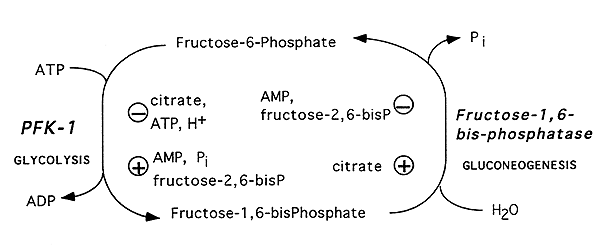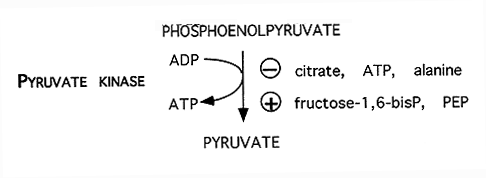Allosteric Regulation
Review: Adenylate Kinase: an "Important Metabolic Regulator"
ATP + AMP <---> 2 ADP
During intense exercise: large conversion of ATP to ADP with the muscle attempting to phosphorylate ADP back to ATP, this increase in ADP pushes the reaction to the left (mass action effect)
i.e. a 20% decrease in ATP leads to an almost 3-fold increase in ADP and ultimately a 1,400% increase in AMP
The increase in AMP is what's important here......
Because AMP is an allosteric regulator that signals a low energy state in cells --------->
rise in AMP increases metabolism through pathways to restore energy (i.e. glycolysis, citric acid cycle etc.).
Hexokinase / Glucokinase: both irreversible
Glucose + ATP ----> Glucose-6-phosphate + ADP
Hexokinase:
Catalyzes the phosphorylation of hexoses in general and is found in all cells that metabolize glucose.
Has a low Km (high affinity, strong binding) so that it is active even at low glucose concentrations.
Feedback inhibited by its product glucose-6-phosphate. Prevents build-up of glycolytic intermediates and the unnecessary hydrolysis of ATP.
Glucokinase:
Glucose specific, found in liver only. Synthesis induced by insulin.
Has a high Km (low affinity,weak binding) to ensure an appropriate response to elevation of glucose from the diet, provides kinetic control.
High Vmax (rapid phosphorylation of glucose).
Phosphofructokinase-1 (PFK-1): glycolysis, irreversible
Fructose-6-phosphate + ATP ------> Fructose-1,6-bisphosphate + ADP
Rate-Limiting, Major Regulated Step.
The concentration of AMP increases when energy is low. Excess phosphate also signals low energy (via increase in ATP use). -------> glycolysis must increase to meet energy demands by metabolizing glucose.
Allosterically (+) AMP, F-2,6-bisP, phosphate
Allosterically (-) ATP
Fructose 1,6-bisphosphatase: gluconeogenesis, irreversible
Fructose-1,6-bisphosphate ------> Fructose-6-phosphate
Can form a futile cycle with phosphofructokinase-1 (PFK-1)
The two enzymes are reciprocally regulated or ATP would be lost without energy conservation. Prevents futile cycling (like using a stationary bike).

Allosterically (+) citrate (high flux of carbons from glucose to the citric acid cycle requiring decreased glycolysis and increased gluconeogenesis).
Allosterically (-) AMP, Fructose-2,6-bisP
Fructose-2,6-bisphosphate:
Formation: Phosphofructokinase-2 (PFK-2)
Breakdown: Fructose-2,6 bisphosphatase (FBPase-2)

PFK-2 is NOT a glycolytic enzyme.
It does use some Fructose-6-P from the pathway, but Fructose-2,6-bisP is strictly an allosteric regulator of PFK-1.
High Glucose: dephosphorylated ----> PFK-2 active ----> Fructose-2,6-bisP produced ----> (+) glycolysis, (-) gluconeognesis.
Low Glucose: phosphorylation ----> FBPase-2 ----> Fructose-2,6-bisP removed ----> (+) gluconeogenesis, glycolysis (-)
Pyruvate Kinase: "Substrate Level Phosphorylation"
Phosphoenolpyruvate + ADP -------> Pyruvate + ATP
Irreversible, Highly Regulated.
Produces 2 ATP.

(-) Citrate (high flux of carbons from glucose to the citric acid cycle requiring decreased glycolysis and increased gluconeogenesis)
ATP. Both prevent the build-up of phosphorylated intermediates.
Alanine, a major precursor for gluconeogensis
(+) Fructose-1,6-bisP, PEP (ensure that intermediates between are kept at a minimal conc.)
Pyruvate Carboxylase:
Mitochondrial enzyme, requires biotin as a prosthetic group to carry CO2.
Requires ATP.

Activated (+): by acetyl CoA (diverts some of the Pyruvate) in concert with the inhibition (-) of Pyruvate DH.
© Dr. Noel Sturm 2015